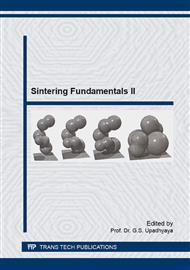[1]
A. Šalak, Ferrous Powder Metallurgy, Cambridge UK, Cambridge Int. Science Publ. (1995).
Google Scholar
[2]
H. Danninger H, Moderne Legierungssysteme für die PM-Formteile – Konsequenzen für das Sintern, in H. Kolaska (Ed. ), Pulvermetallurgie in Wissenschaft und Praxis Band 22 2006 pp.21-47.
Google Scholar
[3]
J. Tengzelius, S-E. Grek, and C. A. Blände, Limitations and Possibilities in the Utilization of Cr and Mn as Alloying Elements in High Strength Sintered Steels, in H.H. Hausner, H.W. Antes, G.D. Smith (Eds. ) Modern Dev. in Powder Metall. 13 MPIF, Princeton, N.J. 1981 pp.159-182.
Google Scholar
[4]
A. Šalak, M. Selecká, and R. Bureš, Manganese in Ferrous Powder Metallurgy, Powder Metall. Progress, 1 (1) (2001) pp.41-58.
Google Scholar
[5]
A. Šalak, Manganese Vapor-Protection of Premixed Manganese Steels Against Oxidation during Sintering, Powder Metall. Int. (1986), 18 (4), pp.266-270.
Google Scholar
[6]
H. Karlsson, L. Nyborg, S. Berg, Y. Yu, Surface Product Formation on Chromium Alloyed Steel Powder Particles, Proc. EuroPM2001, Nice, EPMA, Shrewsbury (2001) Vol. 1, 22.
Google Scholar
[7]
B. Lindqvist, Chromium Alloyed PM Steels – A New Powder Generation. Proc. EuroPM2001, Nice, EPMA, Shrewsbury (2001) Vol. 1, pp.13-21.
Google Scholar
[8]
D. Chasoglou, E. Hryha, M. Norell, L. Nyborg, Characterization of surface oxides on water-atomized steel powder by XPS/AES depth profiling and nano-scale lateral surface analysis. Applied Surface Science 268 (2013) pp.496-506.
DOI: 10.1016/j.apsusc.2012.12.155
Google Scholar
[9]
L. Nyborg, E. Hryha, Surface Oxides on Gas and Water Atomized Steel Powders Advances in Powder Metallurgy & Particulate Materials-2014, Proceedings of the 2014 International Conference on Powder Metallurgy & Particulate Materials, Orlando, FL, MPIF, Princeton, NJ 2014 Vol. 2, pp.153-161.
DOI: 10.1179/pom.1985.28.4.237
Google Scholar
[10]
D. Chasoglou, E. Hryha. L. Nyborg, Methodology for Evaluating the Oxide Distribution in Water Atomized Steel Powder. Proc. Euro PM2009, Copenhagen, Denmark, Oct. 12-14, 2009, EPMA, Shrewsbury UK 2009 Vol. 2, pp.181-186.
Google Scholar
[11]
D. Chasoglou, Hryha E. Nyborg L, Oxide Distribution in Prealloyed Water Atomized Steel, in Powder Proceedings of World PM2010, Florence, EPMA, Shrewsbury UK 2010 Vol. 1, pp.651-69.
Google Scholar
[12]
H. Danninger, C. Gierl, G. Leitner, K. Jaenicke-Rössler, A simple method to study the degassing and reduction processes during sintering of ferrous powder compacts P/M Sci. & Technol. Briefs 6 No. 3 (2004) pp.10-14.
Google Scholar
[13]
G. Leitner, T. Gestrich, K. Jaenicke-Rössler, G. Gille . Modelling of sintering of hardmetalls, Proc. EuroPM2002 European Conf. on Hard Materials, Lausanne, EPMA, Shrewsbury (2002) pp.37-45.
Google Scholar
[14]
H. Danninger, C. Gierl, G. Leitner, K. Jaenicke-Rössler, De-gassing during Sintering of Different Fe and Fe-0. 8%C Powder Compacts, Proc. PM'98 Powder Metall. World Congress Granada, EPMA, Shrewsbury, UK 1998 Vol. 2, pp.342-347.
Google Scholar
[15]
H. Danninger, C. Gierl, S. Kremel, G. Leitner, K. Jaenicke-Rössler, Y. Yu, Degassing and deoxidation processes during sintering of unalloyed and alloyed PM steels, Powder Metall. Progress 2 No3 2002 pp.125-140.
Google Scholar
[16]
H. Danninger, Asymmetrical ferrite-austenite transformation during vacuum sintering of plain iron compacts, Powder Metall. Progress 3 No. 2 (2003) pp.75-85.
Google Scholar
[17]
H. Danninger, C. Gierl, V. Vassileva, Asymmetry Effects in Ferrite-Austenite Transformation During Sintering of Carbon-Free Ferrous Alloys, Proceedings EuroPM2005, Prague, EPMA, Shrewsbury UK, Vol. 1 2005 pp.15-20.
Google Scholar
[18]
H. Kuroki, H. Suzuki, Coarse columnar structure of transformation-grown ferrite in pure Iron - On wrought iron and sintered iron, Materials Transactions Vol. 47 No. 10 (2006) pp.2449-2456.
DOI: 10.2320/matertrans.47.2449
Google Scholar
[19]
H. Danninger, A. Avakemian, C. Gierl-Mayer, M. Dlapka, M. Grafinger, Methane formation through substrate-atmosphere interaction during sintering of Si containing steels, Proceedings Euro PM2014, Salzburg, EPMA, Shrewsbury UK 2014, paper no. EP14038.
Google Scholar


